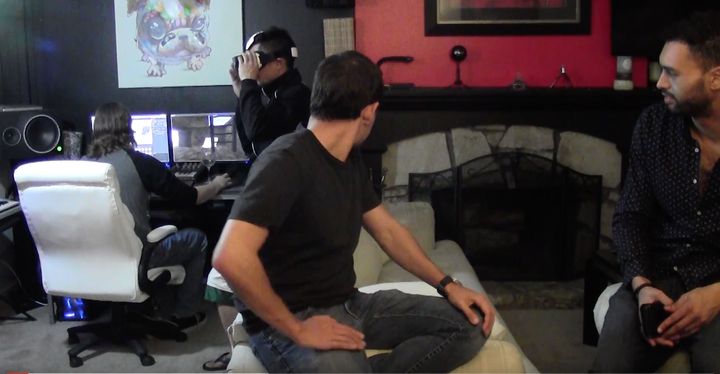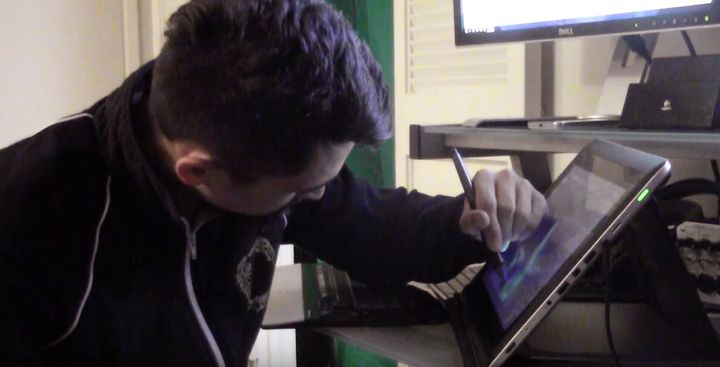Ten millennial aged men gathered in a cozy two-story home in San Diego, California. But not for the sake of hanging out.
Some were parked at work stations. One modeled 3D characters on his computer. Another navigated around a 3D world he was creating for a video game. Another scrolled through a marketing video he produced.
Sometimes the guys strayed from their projects and congregated in the living room, entertained by virtual reality headsets and the basketball game on TV. They shuffled past a giant green screen in the hallway adjacent to the kitchen.
Among them was Chris Hayward, a 32-year-old 3D artist and veteran of the visual effects and gaming industries. It’s where he landed after three lay-offs in six years: at a home-based studio where up to 10 digital media professionals at a time work on their own entrepreneurial and freelance endeavors. They contract each other on projects — whether a video game, mobile app, video, or website.
“I’m not a one-man company. I’m everyone,” Hayward said. “We have a person for every piece of the pie. Whether it’s someone who needs sound engineering or coding or viz (visualization).”
The men and a few women call themselves a “digital collective.” It’s like an organically formed coworking space: a group of peers working independently and collaboratively in one space, leveraging each other’s skills to get ahead financially.

Freelancers and entrepreneurs work out of a home-based studio in San Diego, CA
Such a work arrangement is a result of a growing gig economy, the democratization of technology, and a more entrepreneurial attitude toward work.
Some, like the digital collective, are coworking on the outskirts of the formal coworking economy, where businesses marketed as coworking spaces charge a membership fee. The 2015 Global Coworking Survey conducted by coworking magazine DeskMag counted around 8,700 of them worldwide, a 49 percent increase from a year before. The survey projected 10,100 spaces by the end of 2016.
Coworking spaces cater to growing swaths of freelancers and entrepreneurs. The number of workers in alternative work arrangements as their main job rose over five percentage points to 15.8 percent from 2005 to 2015, according to the RANDPrinceton Contingent Worker Survey. That category includes more than just bearded, hipster entrepreneurs. It counts temporary help agency workers, on-call workers, contract workers, and independent contractors.
Aggregating workers who have compatible skills and missions can be advantageous for the greater good. Just ask Ani Okkassian, managing director of Impact Hub Los Angeles, a coworking space for socially conscious entrepreneurs.
Bringing together people with a different expertise, all of whom are driven by the same social mission, allows her members to collaborate on paying projects. Okkasian thinks of a coworking space as “the new model for a freelance union, an agency, or a consultancy, so that way their membership dues allow them to basically get paying gigs.”
That’s the idea at Lawbank in Denver, a coworking space with 72 lawyers helming their own practices. To help serve one of his real estate clients, co-founder Jay Kamlet contracted the services of an eminent domain lawyer at the space. “He billed me at $400 an hour,” Kamlet said. “I billed him at $600 an hour to my client.”
Kamlet says a law firm may not invest in an eminent domain lawyer, a “very arcane practice area.” But with an alternative legal model like LawBank, “I'm able to tap into the human resources around me without having previously invested in that person to get them there,” he said. “They're a tenant already.”
Hayward’s contingent got started when entrepreneurs Harrison Schaen and John Ashcroft moved into a two-story home in Oceanside, a seaside community in northern San Diego County. In 2015, Schaen, 31, started Issue Fixers, a digital marketing and web development company.
“The business started growing and we needed space to have people come work whenever they wanted,” Schaen said. “We wanted to transform the house into a collaboration zone. One of the bedrooms was for audio production. Another was for video production. Another was for web development and mobile app development.”
Schaen hires independent contractors, which lowers overhead and costs to clients. He provides those contractors with free space to work on their own endeavors, along with complimentary Internet.

Chris Hayward focuses at his dedicated workspace
Others not directly related to Issue Fixers have been roped in, because “I believed in their passion and what they were doing,” Schaen said. “I wanted to feed off their energy as well.”
Schaen said there have been up to about 10 different businesses operating out of the house at one time. “These different people are entrepreneurs,” he said. “People who had a nine to five, just left their nine to five, have a part time job, and just have an idea, have a dream they want to pursue.”
“Having a community of people who excel in their field and being able to tap them whenever you need to — I guess that's the goal right?” Schaen said.
One night, Hayward was invited to a party at the home of Schaen and Ashcroft. Schaen showed him his virtual reality headset. They bonded over a mutual interest in designing for the technology. Then began brainstorming sessions and Hayward became a regular at the home-based studio.
Issue Fixers at one point hired Hayward to produce animated 3D objects for a client video. Hayward also began collaborating with Ashcroft, who owns Time West Studios, on a virtual reality horror video game.
“Because of the three layoffs, I feel confident investing in these guys and creating our own as opposed to being hired somewhere else,” Hayward said. “I feel like as artists, we are taking the power back.”
The job market for 3D artists, who create CGI in movies and imagery in video games, is notoriously precarious. They are frequently hired and fired on a project basis and compete with cheaper labor overseas. “Every year, you're almost scared. When am I going to get laid off?” Hayward said.
His new work arrangement has been made possible by powerful and free technology that was once very expensive and accessible only to large companies. The technology at the core of Hayward’s work is called a game engine, software used to build 3D worlds in which you can interact as a player, like what you see in video games and increasingly nowadays, in virtual reality. Now professional level software, without too steep a learning curve, is available for free.
“I learned all the skills necessary when I was in the industry,” Hayward said. “I've taken all those skills and I’m bringing them back home now. And making a name for myself.”
